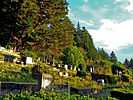Gardiner, Oregon
|
Gardiner Historic District | |
.jpg) | |
|
The Gardiner Historic District in 2011. | |
 The Gardiner Historic District boundaries. | |
| Location | Gardiner, Oregon, roughly bounded by 3rd, Camp, 2nd, Pitt, Spring, Front and Garden Streets[1] |
|---|---|
| Nearest city | Reedsport, Oregon |
| Coordinates | 43°43′49″N 124°06′36″W / 43.730278°N 124.11°WCoordinates: 43°43′49″N 124°06′36″W / 43.730278°N 124.11°W |
| Area | 35 acres (14 ha)[1] |
| Built | 1870–1940[1] |
| Governing body | various private, local public[1] |
| NRHP Reference # | 93000003 |
| Added to NRHP | January 31, 1994[2] |
Gardiner is an unincorporated community and census-designated place in Douglas County, Oregon, United States, across the Umpqua River from Reedsport. It is located on U.S. Route 101. As of the 2010 census, it had a population of 248.[3]
Gardiner is named for a Boston merchant whose ship, the Bostonian, shipwrecked at the mouth of the Umpqua on October 1, 1850.[4] Gardiner was seeking to trade along the river, and most of his goods were saved from the ship and moved to the location that came to be the town of Gardiner.[4] In 1851, the site became the headquarters of the Umpqua customs district, and a post office named "Gardiners City" was established the same year.[4] The name of the post office changed to "Gardiner City" and eventually to its current name.
The Gardiner Historic District, which encompasses nearly all of Gardiner,[1] has been listed on the National Register of Historic Places since 1994.[2] Several steamboats were constructed at Gardiner for trade up the Umpqua River.
A plywood plant opened in Gardiner in 1954, joining the lumber mill (or sawmill) that had been in the town for many years.[citation needed]
Gardiner was formerly the site of the first International Paper mill on the West Coast.[5] The paper mill operated from 1963 until 1999, and was one of the largest employers on the southern Oregon Coast.[6] The mill buildings were demolished in 2006.[6]
A railroad, the Longview, Portland & Northern (LP&N), served the IP mill until it closed.[7] The railroad runs from East Gardiner Junction to the old plant site.
Gallery
Notable people
- Alan L. Hart
- Bill Warren, film historian
See also
- Steamboats of the Oregon Coast
- National Register of Historic Places listings in Douglas County, Oregon
Climate
This region experiences warm (but not hot) and dry summers, with no average monthly temperatures above 71.6 °F. According to the Köppen Climate Classification system, Gardiner has a warm-summer Mediterranean climate, abbreviated "Csb" on climate maps.[8]
References
- ↑ 1.0 1.1 1.2 1.3 1.4 Young, Ella Mae (December 10, 1993), National Register of Historic Places Registration Form: Gardiner Historic District (PDF), retrieved April 1, 2013.
- ↑ 2.0 2.1 Oregon Parks and Recreation Department, Oregon Historic Sites Database, retrieved April 2, 2013.
- ↑ "Profile of General Population and Housing Characteristics: 2010 Demographic Profile Data (DP-1): Gardiner CDP, Oregon". U.S. Census Bureau, American Factfinder. Retrieved February 10, 2012.
- ↑ 4.0 4.1 4.2 McArthur, Lewis A.; Lewis L. McArthur (2003) [1928]. Oregon Geographic Names (Seventh Edition ed.). Portland, Oregon: Oregon Historical Society Press. p. 392. ISBN 0-87595-277-1.
- ↑ "Paper Making Timeline". International Paper. Retrieved 2007-08-29.
- ↑ 6.0 6.1 Chambers, Susan (May 6, 2006). "Eight seconds and it's over". Corvallis Gazette-Times. Retrieved 2007-08-29.
- ↑ Gardiner Division—History of the Longview, Portland & Northern spur line that served the IP plant, from Abandoned Railroads of the Pacific Northwest
- ↑ Climate Summary for Gardiner, Oregon
External links
| Wikimedia Commons has media related to Gardiner, Oregon. |
- The Gardiner that Was by Georgina Durbin from the Douglas County Historical Society
- Historic images of Gardiner from Salem Public Library
- National Register of Historic Places photographic file
| |||||||||||||||||




